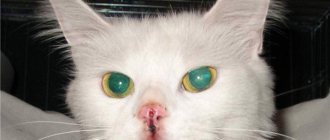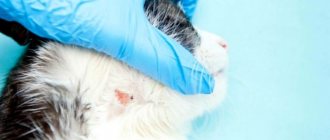What will you learn from the article?
- Skin diseases of cats - types and list
- Skin diseases in cats - symptoms and treatment Flea infestation
- Fungal infections: trichophytosis, microsporia
- Tick-borne infections
- Bacterial infections
- Allergic reactions
Skin diseases in cats are one of the most common problems that both veterinarians and owners of furry and hairless pets have to deal with. Cats who visit the street from time to time are most at risk of getting skin diseases. Animals that permanently live in an apartment are also not immune from them.
Despite their prevalence, skin diseases in cats require serious long-term treatment, many of them can lead to serious consequences and seriously undermine the health and immunity of the animal. And some pose a danger to human health.
Therefore, at the first signs of pathology, the cat must be shown to a veterinarian. Only a doctor can make a correct diagnosis and prescribe an effective treatment for skin diseases in cats that is safe for the pet and the owner.
Sores under a cat's fur: Symptoms
It can be difficult to notice any changes in the skin under a cat's fur, especially if it is thick and long. Groom your pet regularly - comb it. Then it will be easier to detect the problem at an early stage.
The owner may notice itching. Also, at the site of damage, the fur may fall off in shreds along with the crust. The skin may be red and have an unpleasant odor.
Seborrhea (dandruff) often occurs. You need to pay attention to all these signs and contact a veterinary dermatologist for diagnosis.
Watch the video: Fleas in cats - How to get rid of them, what medications to buy
The cat has sores under its fur: Causes
More often, sores appear on the skin due to itching. The cat scratches itself until wounds form that become crusty.
The causes of sores can be different:
- Infestation with parasites . For example, fleas or scabies mites. The most common scabies mites are cheyletella, notoedros and demodex. If demodicosis is detected in a cat, then this is a reason to conduct additional research - to exclude immunosuppressive conditions caused by oncology, endocrinopathies
- Autoimmune diseases . In this situation, the lesions are often symmetrical.
- Endocrine pathologies . Uncommon, but they cause itching and secondary infection.
- Paraneoplastic syndrome . Lesions of the pancreas and liver. An extremely rare pathology. Do not mistakenly consider any disease of the hepatobiliary system to be the cause of itching and damage to the skin.
- Pyoderma . This is an infectious inflammation of the skin. It can be both a primary and secondary cause of lesions. Most often, overgrowth of Malassezia fungi and coccal microflora is recorded. It is worth noting that bacteria and yeast-like fungi are a normal phenomenon on the surface of the skin, it is important to understand the quantity, for this a cytological examination of the skin is performed, we will talk about it later.
- Ringworm . It can also cause baldness. It most often affects young, old and immunocompromised cats.
- Injuries . For example, caused by other cats. Their claws and teeth leave pinpoint wounds that become crusty, and underneath there is active purulent inflammation. The cat may feel unwell, lethargic, or hot due to the increase in temperature.
- Local reaction to drugs . Wounds often appear at the base of the neck or on the withers after applying drops against parasites or during subcutaneous administration of drugs. Unfortunately, this is impossible to predict.
- Food allergy . Intolerance to food components.
- Reaction to environmental allergens.
General treatment tips
You cannot select medications and dosages on your own. The choice should be made by a veterinarian, taking into account the diagnosis and individual characteristics of the cat. Before contacting a veterinarian, Miramistin is allowed to be used. This broad-spectrum drug rarely causes unwanted reactions or complications.
Be sure to complete the course of treatment to the end. If you stop using medications at the first improvement, the disease may recur and become chronic . It will be necessary to take more aggressive medications to cure the cat, both to alleviate the symptoms and to eliminate the cause of the disease.
You cannot refuse treatment. Since the sores cause severe discomfort to the cat, she can scratch them, violating the integrity of the skin. This increases the risk of infection entering the wounds. Purulent complications are possible.
During treatment, medications should not be given without the permission of the veterinarian. Before giving your cat any drug, including dewormers, you need to check its compatibility with the medications used for treatment.
A sick animal should also not be vaccinated: due to a weakened immune system, the reaction can be unpredictable and complications are possible.
Many pathologies are transmitted to people, so owners should follow safety rules when treating a cat so as not to become infected. In some cases, the veterinarian recommends preventative treatment for family members. Do not neglect such recommendations. There is no need to walk a sick cat, as it can easily infect other animals. The risk of complications will also increase on the street.
A cat has lump-shaped sores under its fur: Diagnosis
There is no single test that can be used to immediately make an accurate diagnosis. In some situations, it is even necessary to prescribe empirical treatment.
But first, a cat with sores on its fur will need to undergo tests:
- Exclusion of dermatophytes (lichen) using a Wood's lamp . Instant results, but not all types of mushrooms glow characteristically. Some types of local solutions and ointments can also distort the picture. Do not treat your cat with anything before seeing a doctor.
- A test for detecting flea feces, it is also sometimes called wet or wet. You can do it yourself at home. The cat must be actively scratched with your hand or a brush over a sheet of white, damp paper. If you find black dots, you should try to smear them. If reddish-brown stains are detected, a diagnosis of aphanipterosis-flea infestation can be made.
- Microscopic examination of deep and superficial layers of skin. To collect the material, the veterinarian will slightly scrape the skin using a blunt scalpel and transfer the particles to a glass slide. The procedure is unpleasant for the cat, but not too painful.
- Cytological examination. If the skin is dry and without damage, but only with a hairless area, then it will not be performed. When there is a scab (crust), it is lifted and a smear-imprint is made. The tape test is also used for dry damage. Next, the material is stained and the cellular composition is assessed.
- In some cases, additional research methods will be required: ultrasound, blood, feces, urine, skin histology, intradermal allergy tests, exclusion diet.
Click on the picture to enlarge
Subcutaneous mites
If your cat itches until there are sores on its neck, but no fleas are found, perhaps the cause lies somewhat deeper. It can also be skin diseases, which are a reaction to the activity of subcutaneous mites. They can also be different, but most often they diagnose demodex or sarcoptic mange. In this case, it is also advisable to first have an examination by a veterinarian. If the scraping shows a positive result, the doctor will prescribe the optimal treatment. Usually these are Ivermek injections, or taking it orally according to a special regimen. Intramuscular injections are given every 8-10 days. In total, you need to do three procedures, and you can forget about the problem.
If your cat scratches its neck until it hurts, but there is no way to get to the veterinarian, you can try Ivermec (gel). Just don't apply it to wounds, otherwise you may increase irritation. In addition, Stronghold and Frontline drops are on sale. They are affordable and freely sold through a network of veterinary pharmacies.
The cat has sores under its fur: Is the danger high?
The greatest danger comes from traumatic skin injuries. With the development of diffuse inflammation (phlegmon) or a more local abscess, sepsis can develop, which can lead to the death of the cat.
But in most cases, everything is not so scary, all dermatological diseases can be treated, although the time frame may be different. In the case of autoimmune diseases, lifelong medication is required.
Also, some causes of skin damage in cats can be contagious to other animals and people.
Blackness in a cat's ears: What is it and how to treat it? – https://strazhchistoty.ru/cleanup/cleancats/chernota-u-koshki-v-ushah.html
If all else fails
The most difficult moment for a loving owner is when he tries different methods one after another, but nothing works. The cat has a sore on her neck, a blood scab, which is also beginning to rot. Until you find the cause, you need to fight at least the effect so as not to trigger the disease. In this case, it is best to choose Terramycin or Amidel spray. They help dry wounds very well and relieve inflammation. But the effect will be temporary, since we have not yet eliminated the cause. However, it is important not to make the situation worse with sepsis, so continue to look for treatment options and in the meantime, keep using the spray or ointment.
Sores under the fur of a cat's neck. What is contagious to people and other animals
- Lichen (dermatophytosis) . The most common disease, which, fortunately, can be quickly treated. Although previously, animals with this diagnosis were euthanized. It’s good that science has now made great strides forward.
- Parasitic diseases . Many types of fleas do not live on the animal, but in the environment, and they do not care whose blood they feed on. Cats, other animals and people can be harmed. Owners often notice small red itchy dots on their legs. Other types of ectoparasites are not dangerous to humans, but can cause problems in other four-legged animals.
Watch the video: How to treat lichen in cats - Detailed instructions from a veterinarian
Itching caused by helminths
Helminths in cats Helminths not only have a pathological effect on the cat’s digestion. Worms cause loss of essential nutrients by absorbing micronutrients from the intestines. As a result of lack of nutrition, the pet's skin becomes dry, dandruff appears, and the cat licks itself much more often and more intensely, trying to get rid of the itching.
Intoxication of the animal's body with waste products and toxins produced by worms provokes an allergic reaction, skin rashes, and itching. Even a tiny kitten can suffer from helminthiasis after acquiring parasites from an adult cat. Therefore, if the kitten is itching, it is necessary to check its feces for the presence of worm eggs. The area around the anus may also itch when helminths crawl out to lay eggs. The cat then behaves characteristically - it “rides” on the carpets with its butt, relieving the itching.
Some species are transmitted through flea bites to humans. The presence of worms in kittens leads to delayed growth and development, and in pregnant cats, worm infestation can cause miscarriage. In the presence of individual individuals in the body, the disease can be asymptomatic. Fleas also transmit helminthiasis to other pets, so all inhabitants of the house need to be treated.
Medicines for helminths
If the itching is caused by worms, then it is necessary to deworm the animal. For this purpose, as prescribed by the veterinarian, the animal is given Prasitel, Pyrantel, Trontsil K, Kanikvantel, Profender, Polyvercan (sugar cubes), Panacur, Febtal, Dirofen, Milbemax, Drontal. But first you should undergo an examination and determine the type of parasite, since broad-spectrum drugs are much more toxic than those that act selectively.
Sores on the neck of a cat under the fur: Treatment at home
What can a cat owner do on his own?
- Trim your cat's claws to reduce the risk of injury.
- Also, depending on the location of the problem, in case of severe itching, you can put a bib or blanket on the cat, which can be easily made from a cotton sleeve.
- It won't hurt to treat with flea drops.
- The crusts can be soaked and removed using 0.05% chlorhexedine.
- It is better not to use other medications before seeing a doctor, as this will blur the picture and interfere with diagnosis.
Do cats need to be washed and if so, how? Tips for bathing tailed cats - https://strazhchistoty.ru/cleanup/cleancats/nado-li-myt-koshek.html
Sores under a cat's fur: Therapy
The approach to treating any dermatological problem must be comprehensive. A magic pill “for everything” has not yet been invented.
Therefore, the most common means are:
- Drops for treatment against blood-sucking parasites . Unlike sprays, shampoos and collars, this is the most convenient and effective form of applying the drug. There are convenient spot-on products on the market that work not only against surface pests, but also against parasites living inside. Such drugs include Broadline, Inspector, Helmintal.
- Local remedies . In the form of emulsions, gels, sprays, foams, antiseptic solutions, and so on, they are used mainly for local lesions. For example, Chlorexiderm, available in different forms, Cortavance, Stop-itch spray, Liverazol. All of these drugs have anti-inflammatory effects, some have antifungal and antimicrobial activity.
- Antibiotics . For oral administration. More often in dermatology, high doses of cephalosporins or penicillins are used. The course is also quite long, from three weeks.
- Shampoos, tablets, injections, suspensions . For example, Dexamethasone . These drugs are not recommended for use without medical supervision.
- Vitamins, minerals, dietary supplements . Help restore skin and improve hair growth. For example, Essential drops on the withers or Excel Brevers tablets.
- Diet . They use diets with an enhanced formula aimed at restoring the skin. Or for the diagnosis and treatment of food allergies. There is a so-called elimination diet. Its essence is that for 4 weeks a new monoprotein food or with split protein molecules is introduced into the cat’s diet. After completing the course, they give the usual diet and record the reaction. If a food allergy is confirmed, dietary food is prescribed for a long term or for life.
Sores on a cat’s neck under the fur: Where to go?
Moscow:
- Movet . The clinic is open 24 hours a day. Performs all types of modern research. It is also possible to call a doctor at home.
- Veles . 30% discount on service for guide dogs. There are also other promotions. Unfortunately, specialists do not work around the clock, but this does not affect the quality of services.
Saint Petersburg:
- Elvet clinic network . I work around the clock. It is worth keeping an eye on constantly updated promotions and discounts on the website.
- Veterinary Clinic named after. Ivan Fillmore . Separate entrance for domestic and stray animals. This does not affect the quality of the services provided. Our specialists will provide quality care to all patients.
Quantity










